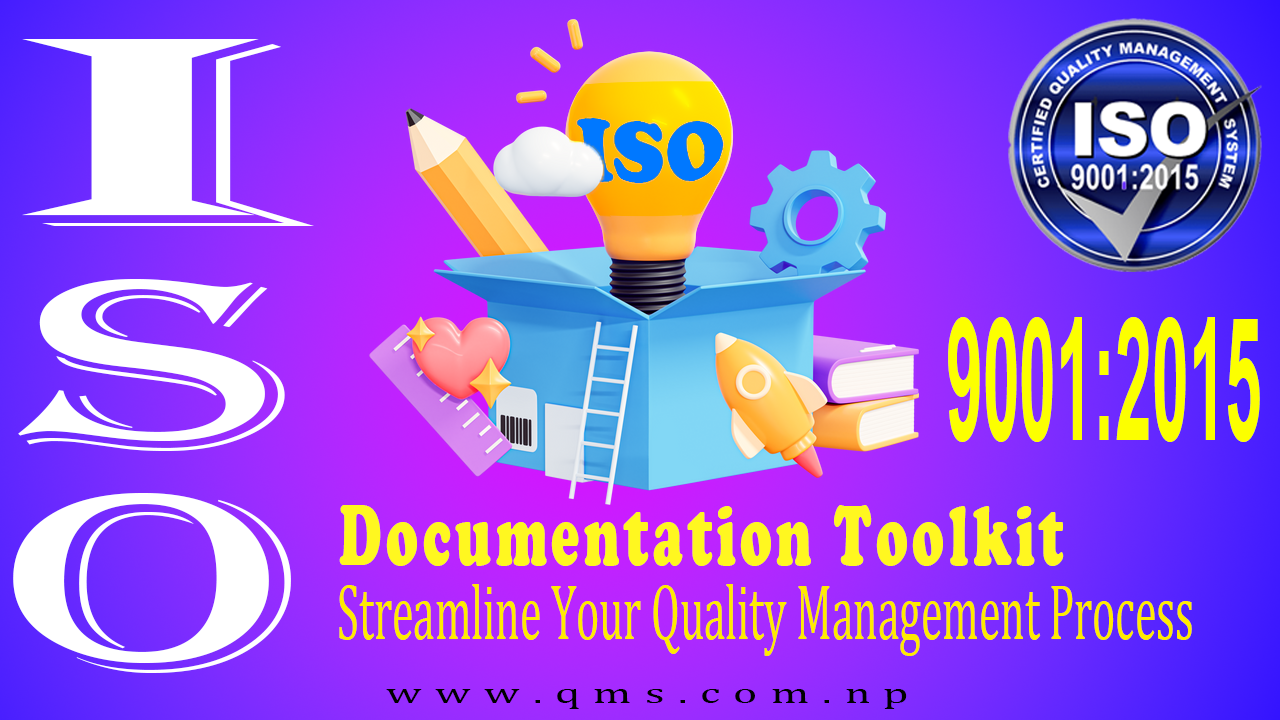Table of Contents
QMS Documentation: The Blueprint for Quality, Compliance, and Continuous Improvement
Introduction
A well-defined and meticulously documented Quality Management System (QMS) is the cornerstone of any organization that prioritizes quality. QMS documentation functions as a comprehensive roadmap, outlining your company’s commitment to quality, its internal processes, procedures, and how it consistently meets the highest quality standards. At Quality Management System Nepal Pvt. Ltd., we understand the complexities of QMS documentation and are here to guide you through its essential components.
Understanding QMS Documentation and Its Importance
QMS documentation encompasses a wide array of documents and records that meticulously detail every aspect of your quality system. This documentation is critical for:
- Ensuring Consistency: Consistent execution of processes minimizes errors and product/service variations.
- Demonstrating Compliance: Aligning with regulations and international quality standards like ISO 9001 requires QMS documentation.
- Training and Knowledge Transfer: These documents serve as a reference for new and existing employees.
- Continuous Improvement: Identifying weaknesses and opportunities for improvement within your quality system.
- Customer Confidence: Demonstrating your commitment to quality through well-structured documentation.

Core Components of Effective QMS Documentation
While the specific structure of your documentation will vary depending on your unique industry and processes, here’s a breakdown of essential components:
- Quality Policy: Outlines your commitment to quality and sets expectations for your organization (consider including your quality objectives).
- Quality Manual: A high-level document describing your QMS framework, key processes, and any relevant quality control and quality assurance practices.
- Procedures: Detailed, step-by-step instructions on executing quality-related tasks.
- Work Instructions: Guides with clear steps for operational processes.
- Forms and Records: Templates and documents used to capture quality data such as inspection reports, corrective action records, test results, and customer feedback.
- ISO Documents List (if applicable): Index and track any ISO documentation specifically required for your QMS implementation.
The Importance of ISO 9001 in QMS Documentation
The ISO 9001 standard is an internationally recognized framework for establishing and maintaining an effective QMS. While obtaining ISO 9001 certification is not mandatory for all industries, having ISO-aligned documentation provides several advantages:
- Need for ISO 9000: Demonstrates your commitment to quality and enhances your competitive edge.
- Global Recognition: Helps expand into new markets and attracts international clientele that values ISO compliance.
- Focus on Customer Satisfaction: The ISO 9001 standard prioritizes customer needs, leading to improved customer loyalty.
- Streamlined Processes: ISO 9001 helps identify and optimize processes and resource allocation.
Enhancing QMS Implementation with Quality Management Techniques and Tools
Incorporating specific quality management techniques and tools into your QMS strengthens your commitment to quality:
- Quality Standards: Ensure adherence to specific industry standards and best practices.
- Types of Quality Control: Implement appropriate quality control techniques, such as inspections, statistical process control, or acceptance sampling, to monitor product and service quality at various stages.
- Quality Management Techniques: Consider tools such as root cause analysis, process mapping, and statistical analysis to gather data and identify areas for improvement.
- QMS Tools: Invest in QMS software to streamline documentation, audit processes, and analyze quality data for robust decision-making.
ISO 9001:2015 (Latest Version) and Your QMS
If ISO 9001 certification is part of your business strategy, staying updated on the latest version is crucial. The key principles in ISO 9001:2015 emphasize:
- QMS Principles: Risk-based thinking, process approach, customer focus, and leadership.
- Customer Satisfaction: Ensure your QMS addresses customer needs and feedback mechanisms.
- Continuous Improvement: Adopt the Plan-Do-Check-Act (PDCA) cycle for continuous quality system optimization.
- Documented Information: ISO 9001:2015 puts a stronger emphasis on documentation of processes and procedures.
Frequently Asked Questions:
What are QMS documents?
QMS documents are the backbone of a Quality Management System (QMS). They include all the written policies, procedures, work instructions, forms, and records that define your organization’s quality standards and how you achieve them.
Think of them as the “instruction manual” for ensuring consistent quality in your products and services.
What is QMS documentation?
QMS documentation refers to the entire collection of QMS documents within your organization. It’s a comprehensive system for:Outlining your quality commitments
Detailing the steps for meeting quality goals
Recording evidence that you’re following your own quality system
Providing a reference point for employees
What should the documented statement of QMS scope include?
The scope of your QMS clearly defines its boundaries and areas of application. A well-written scope statement will typically include:Products and services covered by the QMS
Specific sites or locations where the QMS applies
Any relevant exclusions or limitations (if applicable)
A brief explanation of why those exclusions exist
Alignment with the overall strategic direction of the organization
What is a QMS document?
A QMS document is any individual document or record that forms part of your Quality Management System. Here are common types:Quality Policy: High-level statement of your quality commitment.
Quality Manual: Overview of your QMS and key processes.
Procedures: Detailed instructions on how to perform specific tasks.
Work Instructions: Step-by-step guides for operational processes.
Forms and Records: Templates and documents to collect and store quality data.
How to get ISO or QMS documentation?
Option 1: Develop it yourself: This requires in-depth knowledge of QMS principles and any relevant standards (like ISO 9001). It can be time-consuming but offers maximum customization.
Option 2: Use templates and guides: Many resources offer pre-written templates that you can adapt for your organization.
Option 3: Hire a consultant: Quality management consultants, like Quality Management System Nepal Pvt. Ltd., provide expertise in developing customized QMS documentation aligned with best practices and specific regulations.
How to number documents as per QMS?
There’s no single “right” way to number QMS documents. The goal is to have a system that’s logical, easy to follow, and supports document control. Here’s a common approach:Hierarchical structure: (e.g., POL-001 for Policy #1, PROC-015 for Procedure #15)
Departmental codes: (e.g.. HR-PROC-005 for an HR department procedure)
Revision numbers: Include a method to track document updates (e.g., PROC-015-Rev2)
What are the documents required for QMS?
The specific documents needed depend on your industry, regulatory requirements, and the size and complexity of your organization. However, some common mandatory documents often include:Quality Policy
Quality Manual
Documented procedures required by the standard (e.g., ISO 9001 may specify procedures for control of documents, internal audits, corrective actions)
Records to demonstrate process compliance and product/service conformity
